Friday, December 30, 2011
Waving the Flag (again)
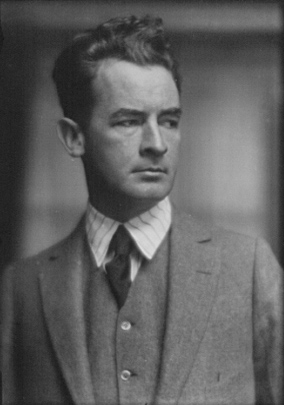
James Montgomery Flagg (1877 - 1960) is a good example of how someone who works for peaceful, productive, market activities can get corrupted by the state in wartime. Flagg began work as a magazine and book illustrator before turning to creating wartime propaganda for the US government during World War I. Here is a fairly typical example of the kind of commercial illustration he did for magazines and newspapers before the war:

[See a larger image] [Source American Art Archives <http://www.americanartarchives.com/flagg.htm>.
He became caught up in the war hysteria and ultra patriotism of the moment and created some of the most memorable propaganda posters of the war, such as the recruiting posters - Uncle Sam "I want you for US Army" (with his likeness used for Uncle Sam and modeled on a British poster with Lord Kitchener urging British citizens to sacrifice themselves for the war effort):
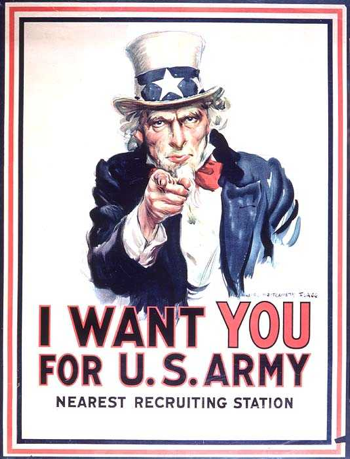
[See a larger image]
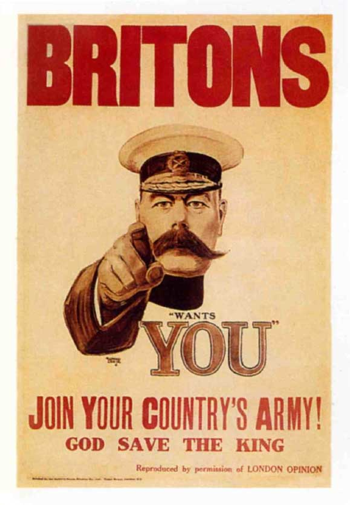
[See a larger image]
and "The Navy needs you! Don't Read American History - Make It!"
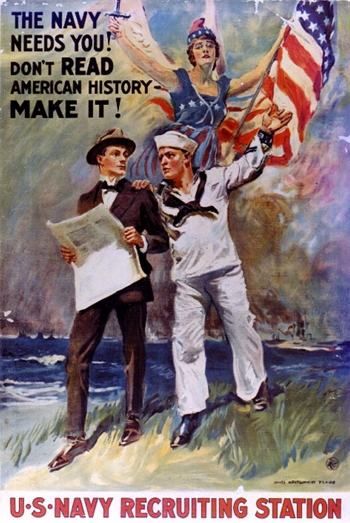
[See a larger image]
and fund raising activities, even urging children to give their savings to the state.
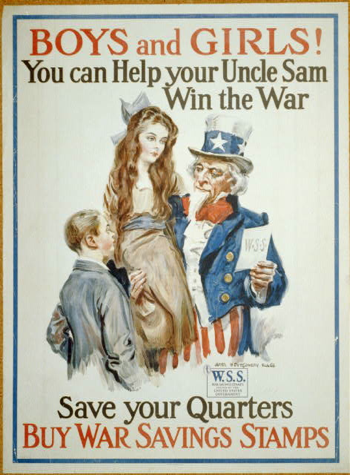
[See a larger image]
In a cover illustrate for Leslie's magazine in 1918 Flagg crudely contrasts the founding "father of our country", George Washington, with the possibility of a German invasion (impossible given the state of Germany's economy and Navy in 1918) which would make the Kaiser the new "stepfather" of the American nation.
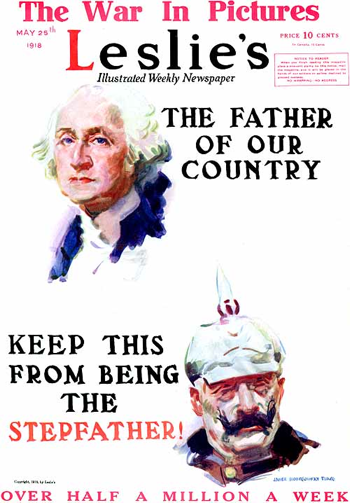
[See a larger image]
After the war he continued to draw posters urging closer Anglo-American ties, such as "Side by Side - Britannia!" (1918)
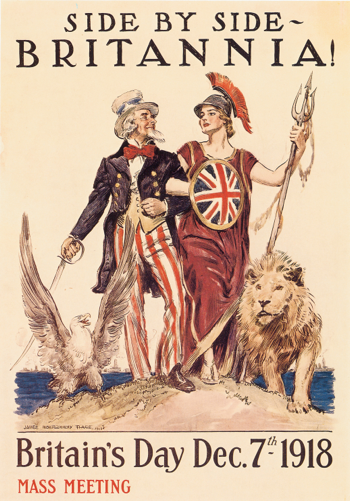
[See a larger image]
and the need for higher taxes and loans in order to fill the government coffers which had been emptied by the war effort (1920). Here we see Uncle Sam frowning at the empty Treasury safe (we could only wish!).
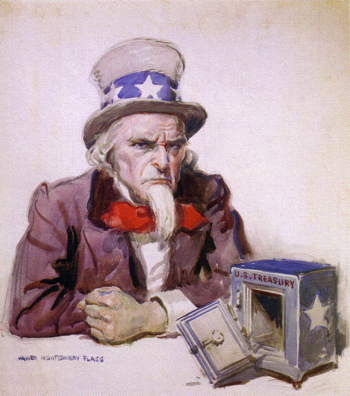
[See a larger image]
Flagg was recalled to duty during WW2 to do for the Roosevelt regime what he had done for Wilson in 1917-1918. In 1942 he did a full page advertisement for McCall's magazine appealing to female consumers to pledge their allegiance to the war effort. Women were encouraged to sign the pledge and be sent an emblem which they were to wear proudly as a token of their commitment. It reads in part "The United States Government's Consumers Pledge for Total Defense", "You are the most important woman in the world", "Join the ranks of home defenders - Today!"

[See a larger image]
In 1943 Flagg returned to his iconic figure of WW1, Uncle Sam (for which he used his own likeness as a model in order to save time), in this demand from the government that "I need your skill in a WAR JOB!" which was followed by a list of key jobs for which the state lacked manpower.
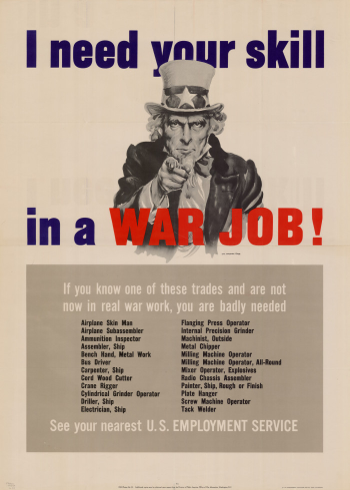
[See a larger image]
Archive of Images of Liberty and Power 1 and 2
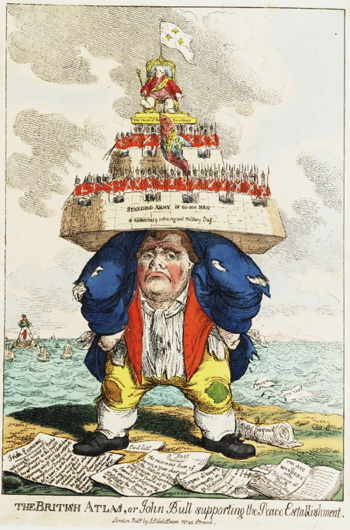
This is a list of the "Featured Images" which have appeared on my main website over the past year or so:
- 0. Peace and Liberty: The Dove of Peace across the Centuries
- 1. Women & Children on Voting Day
- 2. Animal Imagery of War & Peace
- 3. What Daddy did in the War
- 4. Republican & Imperial Leaders (Washington & Napoleon) in their Studies
- 5. The Divine Right of Kings or Regal Tyranny?
- 6. Liberty Slaying the Monster of Tyranny and Oppression
- 7. Monuments to Two 19th Century Free Traders: Frédéric Bastiat (1801-1850) &
- Richard Cobden (1804-1865)
- 8. Images used by the British Abolitionist Movement in the 1780s
- 9. Patriotic Songs which invoke God ("God is on our side")
- 10. "Hail to the Chief" (1810/1812)
- 11. Thomas Hollis' Imagery of Liberty
- 12. New Playing Cards for the French Republic (1793-94)
- 13. Presidents Day and the Apotheosis of Washington
- 14. Tax Return Filing Day and the Tax Eaters
- 15. John Bull, the British Atlas
- 16. An anti-Gaddafi Mural in Benghazi
- 17. Thomas Nast and the Slavery of the Income Tax (1878)
- 18. Press Censorship in Restoration France (1815-1822)
- 19. The Burdens on the Modern Atlas
- 20. Béranger's Song of "The Smugglers"
- 21. Remembrance Day 11.11.11
Archive of Liberty and Power 3
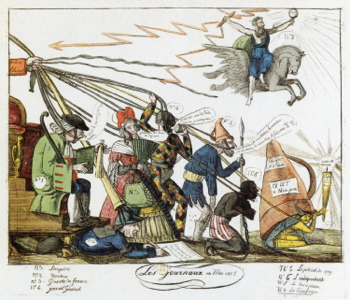
On the Online Library of Liberty I have written a number of "illustrated essays" on important Images about Liberty and Power :
- The Gold Standard vs. Fiat Paper Money
- Eugène Delacroix on Press Censorship during the Restoration (1814-1822)
- Mises on Rationing and Price Controls in WW2
- A Monument to Frédéric Bastiat (1878)
- John Locke and Thomas Hollis
- Jacques Callot, Hugo Grotius, and the Miseries of War in the 17th Century
- The Spanish-American War and the Anti-Imperialism League (1902)
- Brueghel, Taxes, and the Numeration of the People of Bethlehem (1566)
- New Playing Cards for the French Republic (1793-94)
- Abraham Lincoln as the "Federal Phoenix" (1864)
- Algernon Sidney (1622-1683) and the Thomas Hollis Library of Liberty
- Presidents Day and the Apotheosis of Washington
- The Très Riches Heures du Duc de Berry (1416)
- Lilburne quoting Coke on English Liberties at his treason trial (1649)
- Thomas Jefferson in the Cyclopedia
- James Gillray on War and Taxes during the War against Napoleon
- Liberty slaying the Monsters of Tyranny and Oppression
- Images of the British Abolitionist Movement
- The Divine Right of Kings or Regal Tyranny? (Hobbes and Lilburne)
- Monuments to Free Trade: Bastiat and Cobden
- The Earl of Shaftesbury on Liberty and Harmony
- The People and the Ruling Elite in Caricatures (Wade and Daumier)
- Shaftesbury's Illustrations for Characteristicks (1732)
- Washington and Napoleon in their Study
Search with Site with Google
Web |
Wednesday, December 28, 2011
Welcome to David Hart's blog.
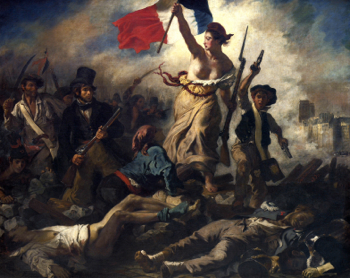
[Delacroix, "Liberty leading the people" (1830)] [See a larger version]
In this blog I want to reflect on the interrelationships between culture, art, and politics as they impinge upon two things which greatly concern me, namely individual liberty and political power. I have two places where I put my longer "pictorial essays" as I call them: at my main website, where I have a section called Images of Liberty and Power; and at the Online Library of Liberty where there is a similar collection.This blog will allow me to do shorter postings as I come across interesting items.
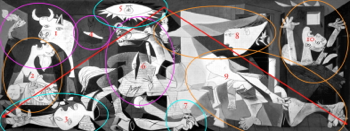
The image I use for the banner comes from an essay and lecture I have on Pablo Picasso's great anti-war painting "Guernica" (1937) in which I analyze the various components in the painting and discuss what Picasso might have intended in using them. The essay was published as Guerra e Arte: Guernica. Pablo Picasso dalla guerra civile spagnola al Vietnam on an Italian art and culture website.
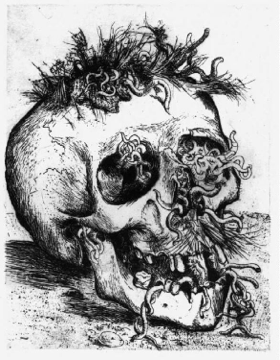
[Otto Dix, "The Skull" from "Der Krieg" (War) (1924)] [See a larger image]
You might also find some of my study guides on war and art interesting as they cover related themes.
Reading History vs. "Making History à la James Montgomery Flagg
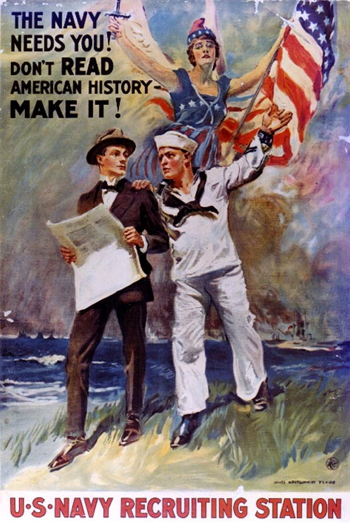
[See a larger version]
When reading Michael Kammen, In the Past Lane: Historical Perspectives on American Culture (OUP, 1999) I came across this piece of war propaganda by James Montgomery Flagg, "The Navy Needs You" (1917). The unintended irony of the image is that if one did read history one might be less inclined to "make history" by going off to fight in an unnecessary or unjust war.
The gloriously named "James Montgomery Flagg" did several dozen propaganda posters for the US government during WW1. Flagg is best known for his "Uncle Sam Needs You" recruiting poster.
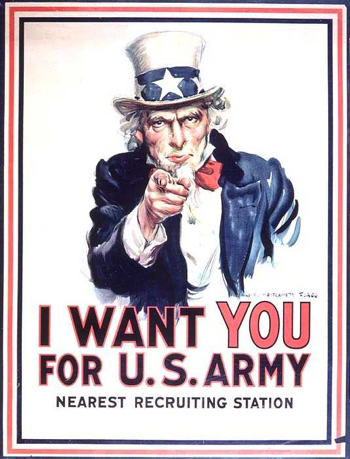
[See a larger version]
If you were a novelist and you gave the name "Flagg" to a super patriot people would laugh at you. This was also the name given to the super patriotic CIA officer in the TV series M*A*S*H and viewers quite rightly laughed at his stupidities.
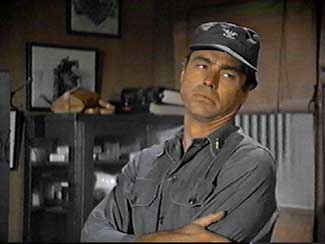
Another of my favorites is Flagg's "Side by Side - Britannia" (1918) in which he links British and American imperialism - Uncle Sam and Britannia have linked their arms together and the American eagle and the British lion are on guard against the enemies of empire:

[See a discussion of the politics of animal imagery] [See a larger version]
The Planet of the Apes I
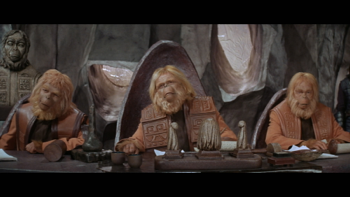
I saw the original "Planet of the Apes" (1968) film last night and was surprised by a couple of aspects: firstly, its strong anti-religious take on the suppression of scientific inquiry; and secondly, its idea of the class structure of ape society with the theocratic class filled by the orangutans, the military class by the gorillas, and the scientific elite by the chimpanzees. Above we see three members of the theocratic class conducting a hearing into the alleged heresy of the chimpanzee scientists who have claimed that a more advanced non-simian civilization existed before the simian one, a view outlawed by their holy texts. [We see the President of the Assembly (James Whitmore), Dr. Zaius (Maurice Evans), and Dr. Maximus (Woodrow Parfrey)].

Above we see three members of the gorilla warrior class who hunt down and exterminate the remnants of the humans.
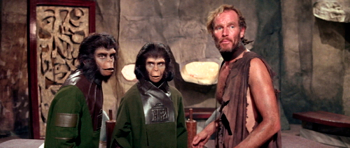
Here we see Taylor (Charlton Heston) and two of the scientist chimpanzees (the female is Zira (Kim Hunter)) who wish to study the apparently mutant human who is capable of speech.
The Yule Goat: the welfare state Santa vs. the predator Santa
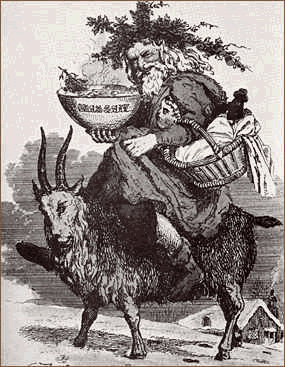
There is a pagan tradition from Scandinavia which I think needs to be revived at this time of the year, namely the Yule Goat. I think all this talk about Santa, sleighs, and reindeers has become rather hackneyed and stale and needs to be replaced with a newer and fresher set of symbols to mark the period of feasting and gift-giving during the winter solstice (summer if you live in the southern hemisphere). According to legend, Thor rode a chariot across the sky pulled by two goats, Tanngrisnir and Tanngnjóstr, after which he would kill them and then serve them to his guests in a banquet. The next day he would suffer remorse at eating his faithful livestock and would bang his hammer on the ground to bring them back to life for another round of similar activities. Seems a little mean spirited to me.
Another mean-spirited yet charming Scandinavian tradition has the Yule Goat (Santa), not giving presents to people, but demanding that they give him presents instead. This is a nice reversal of the welfare state image of Santa as the universal gift-giver (no one ever explains how he pays for all this largesse - I guess they have solved the problem of economic scarcity at the North Pole). We now have the much more realistic story of the statist Yule Goat/Santa who demands booty and plunder every year from the people. You will remember of course that it was the Roman Empire’s need for more taxes that brought Mary and Joseph to Bethlehem to participate in a census to plug the holes in the tax records. It’s nice to see the pagan and Christian religions coming together on this important issue.
Kim II and the Escalator to Hell

I came across this most unfortunate photograph of one of the last public appearances of the Dear Leader Kim Jong-Il (a.k.a. King Kim II) before he died. Shortly after his death this escalator was turned into a shrine where grieving Koreans could go to weep, gnash their teeth, and rent their garments at the loss of their beloved tyrant. Another reading might be that the Dear Leader is on an escalator to hell, followed at discrete and geometrical distances by his sister, “Uncle Jang”, and other assorted party and military leaders who will soon be fighting over the bones of the state he left behind. Our hearts and thoughts are with you Dear Leader! [see article].
Compare the photo with Sandro Botticelli's (1445-1510) painting of the ladder to hell in "A Chart of Hell" (1480s) and his illustrations for Dante's Inferno. Rings 8 and 9 are reserved for corrupt politicians:
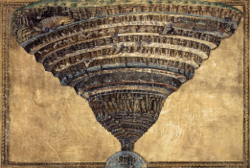
[See a larger image]
Here is how the website Art and the Bible describes it:
This is Botticelli's chart of Hell as described by Dante in his 14th century epic poem Inferno. Dante saw Hell as an abyss, a giant cave leading to the center of Earth. The cave was created when God cast Lucifer out of Heaven. Lucifer is stuck in the center, caught in ice.
In the story Dante describes his journey through Hell, which he made together with his friend the poet Virgil. Descending, they pass nine rings, representing categories of sins.
The first five rings are for people who could not control their desires: lust, gluttony, greed, anger and revenge. Also, unbaptized souls and decent heathens dwell here. Rings six and seven are for heresy and violence: murderers, suicides, blasphemers, and sodomites. Rings eight and nine are for fraud and treachery. Here dwell witches, thieves, astrologers, seducers, corrupt politicians, alchemists and sowers of discord. An interesting detail is that Dante describes meeting the founder of Islam, Muhammad, in that ring. Dante and many of his contemporaries viewed Islam as an off-shoot from Christianity.
See also The World of Dante.
The deification of King Kim II has begun
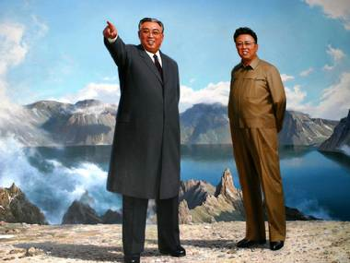
According to an article in the Guardian the deification of Kim Jong-Il has already begun:
When Kim Jong-il was born on the sacred mountain of Paekdu, a star rose above the spot and shone brightly, a double rainbow appeared and spring broke out spontaneously. Did we mention that his nativity was foretold by a swallow? The KCNA line is that once the dreadful days surrounding Kim Jong-il's death are over, a "spring of prosperity under Socialism will surely come to the country thanks to the patriotic devotion of Kim Jong-il who blocked the howling wind of history till the last moments of his life". "The sky turned red, it went on, and cracks appeared in frozen lakes. A Manchurian crane then bowed its head in grief."
Before we get too cocky about the poor North Koreans' love of their departed tyrant we should recall how readily Americans deified George Washington and Abraham Lincoln after their deaths. The worship of power and the powerful is a universal phenomenon, both in democracies and in communist societies.
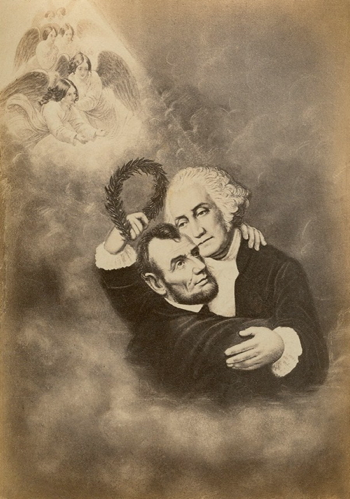
[Unknown, "The Apotheosis of Washington and Lincoln" (1865)] [See larger image]
King Kim II: Born to Salute and be Saluted

Baby Kim II with mummy and daddy (about 2 years old). Saluting authority requires precision and sharp angles.

King Kim II in 2011. When one is in authority one doesn't have to salute anybody but one does acknowledge the salutes of others, even if it is rather perfunctory and flaccid. See the excellent study by Tilman Allert, The Hitler Salute: On the Meaning of a Gesture (Henry Holt, 2008) where this very point is made. Hitler often gave very lackadaisical and sloppy salutes when others saluted him. The angle was also very important, either above or below the heart, straight arm or bent arm.
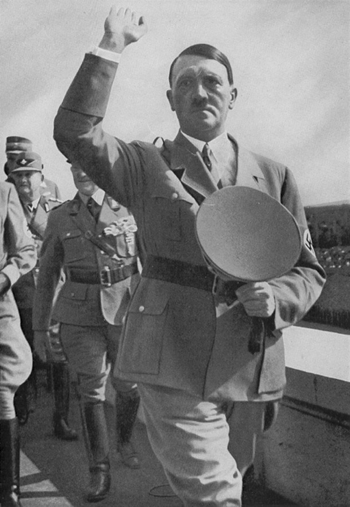
All this saluting was mocked brilliantly by Charlie Chaplin in The Great Dictator (1940) including the different salutes for the saluter and the salutee.
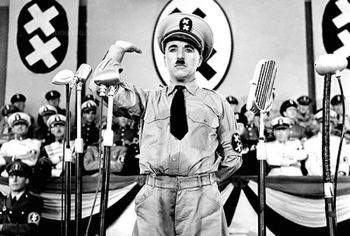
[Adenoid Hynkel is "The Phooey" (Der Führer)]
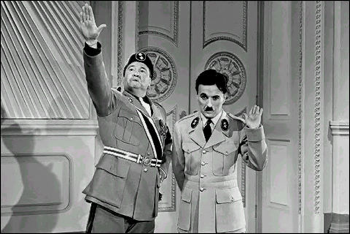
["Benzino Napaloni" (Mussolini, il Duce)]
Mao in his Bathrobe

One of the choicest presents I got when I was in Shanghai was the statue of Mao my wife found in a market. It was of Mao in his bathrobe after he had swum the width of the Yang-tse River.
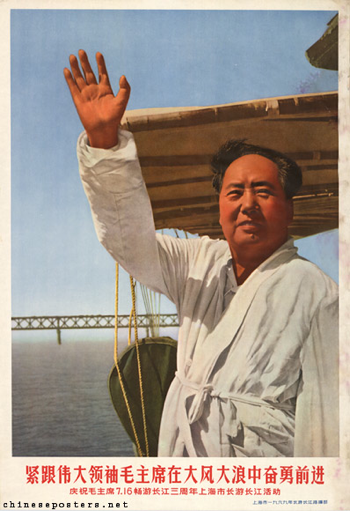
Like any good dictator Mao wanted to show that he had superior physical powers and therefore was worthy of ruling China. He used to swim the width of the Yang-tse river unassisted and then emerge, wrap himself in a bathrobe, and acknowledge the universal acclamation of the adoring Chinese people. The image of him dressed in this fashion was used for propaganda purposes as the poster above indicates. Here is another:
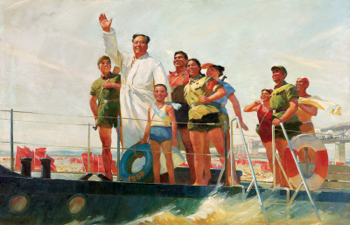
[See larger image]
Art and the Pepper Spray Cop at UC Davis

On November 18 a group of peaceful student demonstrators at the University of California, Davis were pepper sprayed by a campus policeman. A photograph of the event went viral on the internet. There are a number of interesting aspects of this horrifying event: the nonchalance and arrogance of the cop who is methodically spraying pepper into the faces of the seated, unresisting students; the reaction of the university administration; and the way in with the now iconic image of the cop was used in combination with great works of art to make a political point. Here is a sampling of the art which was "violated" by the "pepper spray cop" as he violated the rights of the unresisting students. Many of the "rewordings" of the paintings (and a film) are overtly political, especially those by Delacroix, Picasso, Trumbull, Sargent, and Kubrick. How little could the brutal cop have imagined the political and artistic creativity his action would trigger:
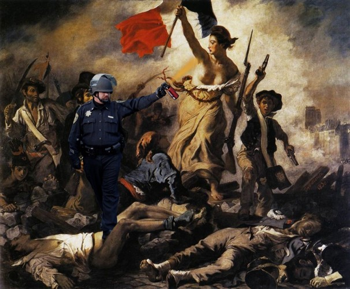
[Delacroix's "Liberty leading the People" (1830)]
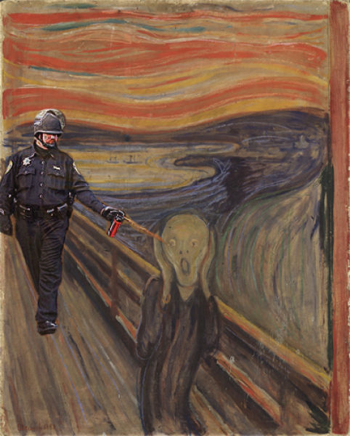
[Edvard Munch, "The Scream" (1893)]

[Picasso's "Guernica" (1937)]

[I couldn't identify the painting but it looks like something by Jackson Pollock]
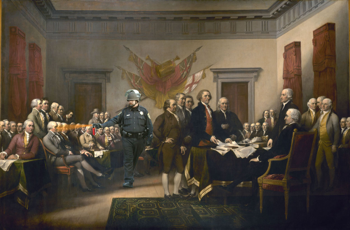
[John Trumbull's "Declaration of Independence" (1819)]

[John Singer Sargent, "Gassed" (1918-1919)]
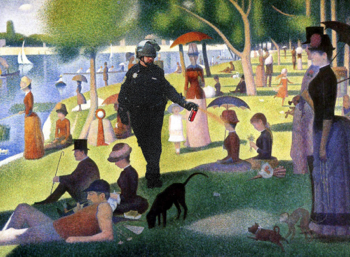
[Seurat's "Sunday Afternoon on the Island of La Grande Jatte" (1884–1886)]
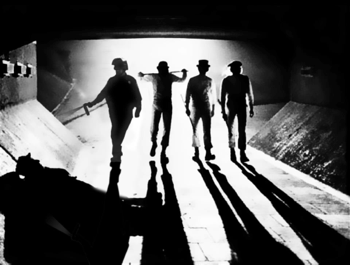
[The "Pepper Spray Cop" is now one of the droogs in Kubrick's film "A Clockwork Orange" (1971)]
Picasso in Sydney
In early December I was able to go to the Art Gallery of NSW to see the Picasso exhibit which consisted of 150 odd pictures and sculptures lent by the Picasso Museum in Paris. I was excited to see for the first time two pictures which I had never seen in the flesh before - "Minotauromachy" (1935) and "Massacre in Korea" (1951). [See my study guide on Picasso's war art for more info].
The "Minotauromachy" (1935) has many references to classical mythology and prefigures some of the imagery which we see a couple of years later in "Guernica" (1937): the bull, the injured horse, the girl/woman with the lamp, people in a window surveying the scene, etc.
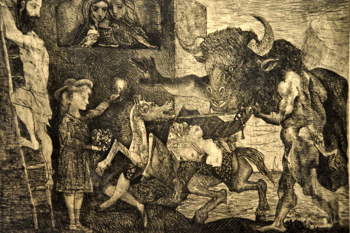
[See larger image]
Compare with this compositional study for "Guernica"(1 May, 1937):
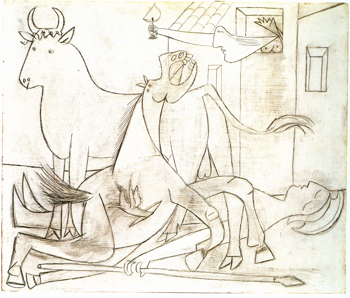
[See a larger image]
The "Massacre in Korea" (1951) has robotic, futuristic soldiers lined up to shoot innocent women and children.
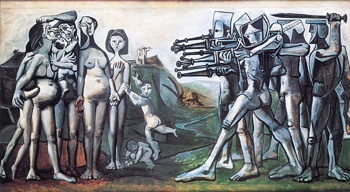
[See a larger image]
Picasso's debt to Francisco Goya's "Third of May", where invading French soldiers round up and execute citizens of Madrid after they rose up in opposition to the occupation of their city, is clear. [See my study guide on Goya for more info]
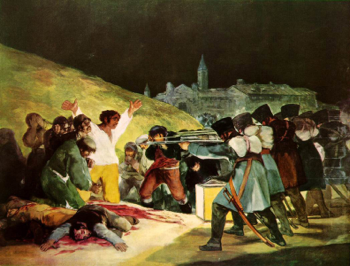
[See a larger image]
